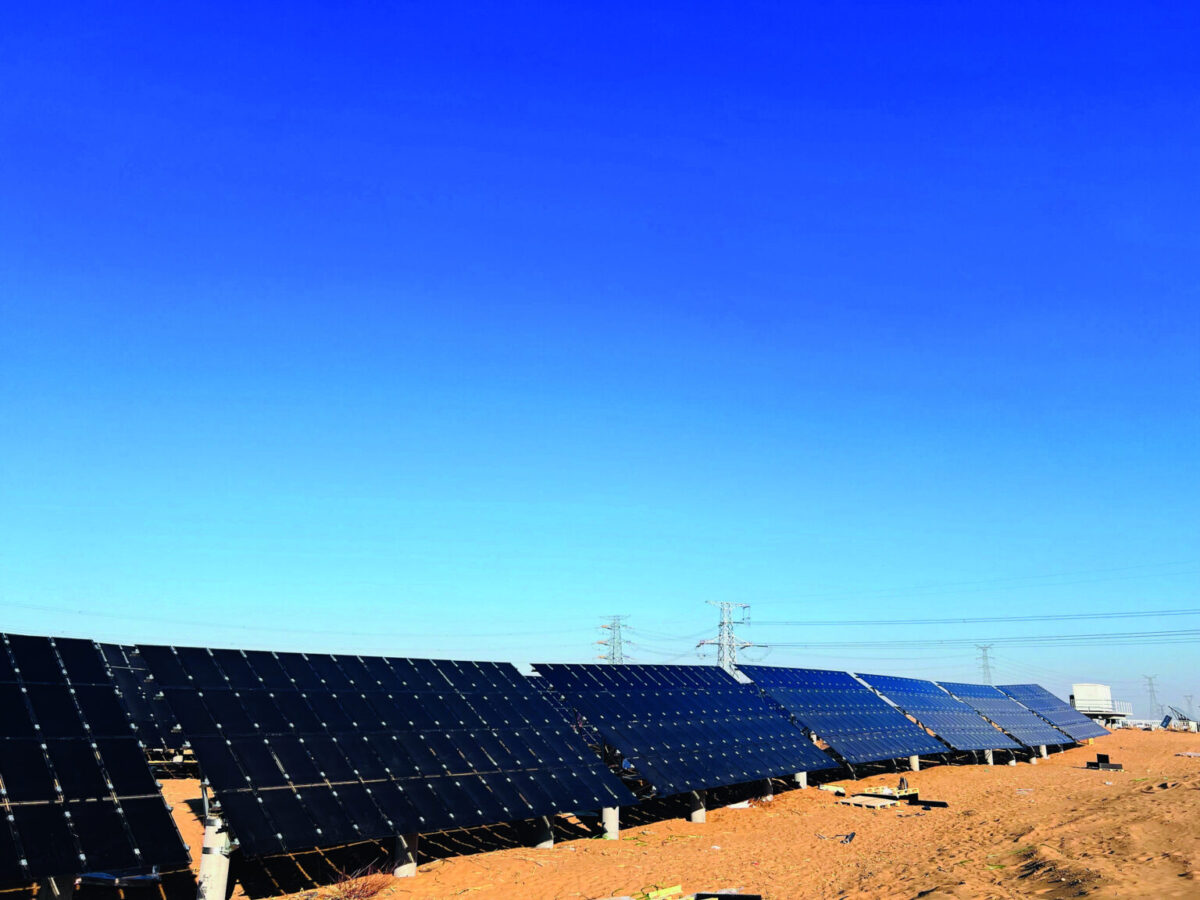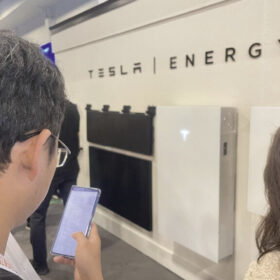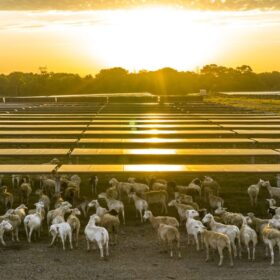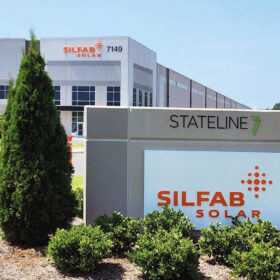From pv magazine
World records for perovskite solar cells have a short shelf life. Until April 2022, a silicon-perovskite tandem cell from Helmholtz-Zentrum Berlin (HZB), a German research organization, led with an efficiency of 32.5%. Researchers at the Photovoltaics Laboratory of the King Abdullah University of Science and Technology (KAUST), in Saudi Arabia, later hit 33.2%, and then 33.7% in May 2023. That record stood for a few months. In early November 2023, a perovskite-silicon tandem cell from Chinese PV manufacturer Longi converted 33.9% of incident sunlight into electricity. “This means that the solar cell efficiency of silicon perovskite tandem cells is now in ranges that could previously only be achieved with III-V semiconductors,” said HZB managing director Bernd Rech, referring to materials such as gallium-arsenide, which offer strong solar cell performance at a much higher cost.
Even single-junction perovskite solar cells without the crystalline silicon or other tandem element are attracting commercial interest. Record after record fell in quick succession in 2023, albeit in increments of tenths of a percentage point. Since November 2023, a group from the Key Laboratory of Photovoltaics at the Hefei Institute in China, with support from German, French, and South Korean scientists, has held the world record with 26.1% efficiency. The successes are based on clever design and the purity of the perovskite crystals. The crystals are, in principle, based on diverse, highly optimized production processes that make it possible to minimize impurities and other defects, which are the most important cause of recombination – where a charge is lost before it can be transported out of the cell.
Knowledge of the fundamental processes within perovskite materials is also growing. For example, Thomas Kirchartz and his team at Germany’s Jülich Research Center discovered a major difference between perovskites and other solar cell materials. In a paper published in the journal “Nature Materials” in January 2024, the group outlined differing roles for “deep” and “shallow” cell-material defects. Kirchartz suspects deep defects, which can occur in silicon, cannot exist in perovskites. “Understanding the processes is crucial to further improving the efficiency of perovskite-based solar cells,” he said.
Lab to fab
“Perovskite solar cells can become a game changer in photovoltaics,” said Michael Powalla, a board member at the Center for Solar Energy and Hydrogen Research Baden-Württemberg in Stuttgart. Values of more than 33% in perovskite-silicon tandem cells could give modules up to 30% efficiency. Most records to date, though, have been achieved with prototypes typically measuring around 1 cm². There is no shortage of unsolved challenges for cells hundreds of times larger. Research institutes and PV companies large and small want reliable, cheap, fast production processes for large cells. Another unresolved issue is the guaranteed durability of perovskite modules that would age as little as possible and give high electricity yields for at least 25 years. “We need everything at the same time: high efficiency, outdoor stability, and scaling with compatible production processes,” said Powalla.
Simple, inexpensive spin coating is sufficient for small tandem laboratory cells. In this process, solutions are thinly distributed on a fast-spinning surface. For larger cells, with an edge length of more than 15 cm, other, less wasteful processes are required. With recent commercial silicon cells boasting up to 21 cm edge lengths, large-area processes are more important.
“Several processes are suitable for this and are currently being tested,” said photovoltaics researcher Kaining Ding, from the Jülich Research Centre. The challenge is that the perovskite crystals must evenly cover the textured surface of the silicon cell without gaps. If the perovskite layer is too thin, the tips of the pyramids on the silicon surface – which are less than 1 micrometer in size – could puncture the perovskite layer and reduce efficiency. On the other hand, if the layer is too thick, it becomes more difficult to collect charge carriers efficiently.
One variant is slot die coating, in which a perovskite solution is applied as an ink-like liquid, and forced through a slot to be evenly applied to a substrate. What then becomes difficult is to precisely control perovskite layer thickness with the process, especially at edges. Perovskite layers can be applied more evenly under vacuum from a vapor phase using a physical vapor-deposition process. The challenge here is finding a perovskite precursor solution that can be completely converted into the necessary vapor phase.
“There is also a hybrid approach that combines the advantages of both process types,” said Ding.
First, a thin, porous, inorganic precursor layer is deposited as a vapor. This is followed by a liquid phase that can be applied by slot die coating or other print- or spray-type processes. This liquid migrates into the porous layer, causing the desired perovskite crystals to grow. Ding said many solar companies are focusing on this hybrid method of wet chemistry and vacuum processes and hope to apply it to full-sized tandem cells in the near future.
A new approach developed by a research group led by Ulrich W. Paetzold, from the Karlsruhe Institute of Technology in Germany, also promises to accelerate developments. The group trained an artificial intelligence device to recognize the smallest deviations in light emission by the cells during the production of tandem devices. The quality of a solar cell could thus be quickly deduced from the light emission.
“Thanks to the combined use of AI, we have an idea of which adjustments we need to make, first and foremost, to improve production,” said Paetzold. This means that experiments can be carried out in a more targeted manner and that production routes can be identified more quickly.
PV modules
Large perovskite silicon tandem cells, or even entire modules, are still hard to find. Anglo-German company Oxford PV has a clear lead, having set up the world’s first series production line for perovskite silicon tandem cells in Brandenburg an der Havel, Germany. At 28.6%, Oxford PV also holds the world record efficiency for a large tandem cell, with a surface area of just over 285 cm².
Others are catching up. In May 2023, Chinese startup Auner presented a tandem cell with a 5 cm edge length and 30.83% efficiency. The company plans to launch a 100 MW pilot production line producing 166 mm cells later in 2024. Swiss manufacturer Meyer Burger also presented a medium-sized (24.5 cm²) cell with 29.56% efficiency as early as 2022, in collaboration with Swiss research center CSEM. Japan-based Kaneka, meanwhile, has hit 28.4% on an 8 cm cell.
Manufacturers of pure perovskite solar cells are striving for faster series production using wet chemical processes such as slot die coating. This is where Chinese companies are making a leap into the market. Last year, for example, Microquanta Semiconductor, based in Hangzhou, started series production of perovskite modules measuring 1.2 m by 60 cm, albeit with efficiencies of less than 20%. Since November 2023, a 1 MW power plant in the Kubuqi Desert in Inner Mongolia featuring those modules has been supplying not only electricity but also valuable data on the durability of perovskite solar cells under real-world conditions.
Silicon solar manufacturer GCL Group has also joined the ranks of perovskite producers with modules measuring 1 m by 2 m and achieving efficiency of 18.04%. The company says a 2 GW production line is currently being prepared in Suzhou, China. Utmolight, which was only founded in 2020, plans to start building a 1 GW production line in 2024 in Wuxi, China, set for completion in 2027. Another 100 MW pilot line is planned for 2024 by startup Mellow Energy. It is targeting 20% module efficiency from modules measuring 1.2 m by 1.6 m, having demonstrated efficiency of up to 22.86% on smaller devices. While those figures are barely competitive with today’s silicon modules, let alone tandem devices, they do offer significantly lower production costs.
Achieving stability
“None of these companies can guarantee the stability of their modules for 25 years,” said Jülich’s Ding. Despite promising results in the laboratory, the durability of perovskite solar cells remains a challenge – both alone and in tandem devices. There is a lack of concrete information from the manufacturers, as well as a lack of measurement data from long-term outdoor use or standards for tough tests that simulate real-life loads of up to 25 years. Laboratory tests on small cells do, however, show how perovskite solar cells can be stabilized, for example, with the addition of certain chemicals. “But there is a gulf between research and industry,” said Ding. Many promising approaches are simply not pursued after publication in renowned scientific journals.
That is precisely the problem that Ding and his colleagues at Jülich and at the HZB want to tackle. Michael Saliba from the University of Stuttgart is also convinced that, with the progress made over the last few years, 20-year stability could, in principle, already be achieved today – provided that the available knowledge is utilized in a bundled manner for the development of sophisticated manufacturing processes.
This means that the hurdles to the low-cost series production of perovskite solar cells – alone or in tandem – appear to be surmountable in the next few years. In a recent paper published in the journal “Science,” Erkan Aydin and his colleagues at KAUST estimated the point at which perovskite-silicon tandem cells will be economically viable compared to standalone silicon. He calculated that higher production costs constitute a premium of 30%. The result is that if a tandem cell loses 2% of its (relative) efficiency every year, the new module should already have an efficiency of more than 32%. If long-term stability can be improved – for example, if a module only degrades by 0.4% per year, similar to today’s silicon PV products – then 24% efficiency would already be sufficient. Then, as forecast by analysts at Rethink Energy, in the United Kingdom, the target of 2 GW of global production by 2026 could easily be achieved. By 2040, some 90% of all solar modules could even contain perovskites.
By Jan Oliver Löfken.
Jan Oliver Löfken.
This content is protected by copyright and may not be reused. If you want to cooperate with us and would like to reuse some of our content, please contact: editors@pv-magazine.com.








By submitting this form you agree to pv magazine using your data for the purposes of publishing your comment.
Your personal data will only be disclosed or otherwise transmitted to third parties for the purposes of spam filtering or if this is necessary for technical maintenance of the website. Any other transfer to third parties will not take place unless this is justified on the basis of applicable data protection regulations or if pv magazine is legally obliged to do so.
You may revoke this consent at any time with effect for the future, in which case your personal data will be deleted immediately. Otherwise, your data will be deleted if pv magazine has processed your request or the purpose of data storage is fulfilled.
Further information on data privacy can be found in our Data Protection Policy.